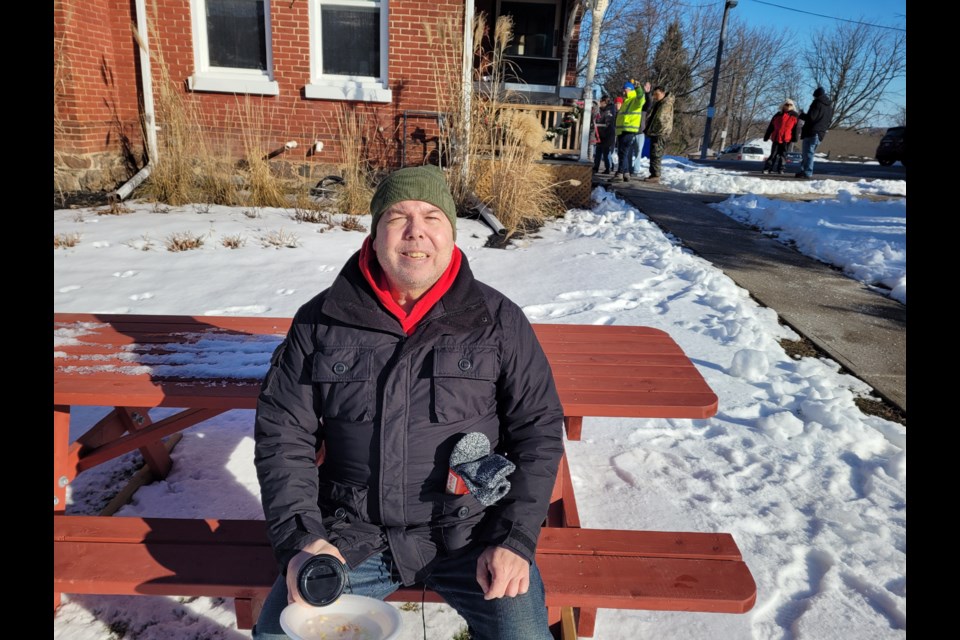When Ends Don't Meet is a regular NewmarketToday series highlighting issues of social equity by sharing the stories of community members left struggling to make ends meet during a far-reaching affordability crisis.
Vincent Fenz has been relying on the Newmarket Food Pantry for about five years, but he has also been impacted by rising grocery prices.
He gets a box of food delivered from the food pantry once a month, he's able to stretch those staples for a couple of weeks' worth of meals. He also shares that food with his adult children. When he is able to get a ride, he occasionally goes to the grocery store.
While he said he has been impacted by rising food costs, he finds ways to adapt.
"I do little things that I learned from other generations, the silent generation. Less meat, more noodles and rice or whatever you’re cooking with. Try to get lots of vegetables in there if you can,” Fenz said.
He said the box from the food pantry is especially helpful as he gets lots of canned vegetables and lentils that he can cook up.
"With rising food costs, soaring rental rates, and inflation numbers at an all time high, more and more people are, unfortunately, turning to a food bank," said Adrian Bain, executive director of the Newmarket Food Pantry.
He said the average price of a one-bedroom apartment in Newmarket is not considered affordable, especially for those receiving government benefits or making minimum wage. He said the majority of food bank users have less than $100 left after paying their housing costs.
The need is not unique to Newmarket.
Second Harvest surveyed 1,300 non-profit organizations that distribute free food to Canadians at the end of 2022. It found that the number of people served grew by 134 per cent in 2022 and that need is expected to increase by another 60 per cent in 2023.
"Without more help, literally thousands of Canadians will not have enough food to feed themselves or their family, making 2023 an even tougher year than any of the time during the pandemic," the report said.
A report released by the Food Bank of York Region last November examined the statistics of who is accessing the 61 food banks and meal providers in its network in 2021.
It found that around 50 per cent of clients are female, 43 per cent are male and gender is unknown for just over six per cent. The majority, 60 per cent, are between the age of 18 and 64.
The primary source of income for more than 33 per cent of households served in 2021 was government benefits like EI, ODSP or OSAP. Thirty-one per cent did not disclose their source of income, 12 per cent have no income, six per cent work part time, 4.8 per cent work full time and 4.8 per cent receive a pension.
In terms of housing status among users, the report found that 46 per cent of households were in a private rental. Just more than 29 per cent did not disclose their housing status. Fifteen per cent were in social housing. The remainder was split between homeowners, people on the street, people in group homes or shelters, and those staying with family or friends.
Some have seen a shift in the types of people depending on food programs lately.
Andrew Hamilton is the pastor of Christian Baptist Church on Main Street, which runs a community barbecue lunch every Wednesday.
He said despite the wintry weather, they have been feeding anywhere from 20 to 60 people every week. He regularly has conversations with those who attend to get to know them and offer a social connection.
Previously, a lot people coming were homeless or living in tents, but Hamilton said lately he has found that about half of the people coming to the meal are housed or have jobs but cannot afford food.
"They come here because otherwise they wouldn't have lunch," he said.
David Carriere relies on the community meal to save money on groceries that can go to other expenses.
He added he also attends because of the friendships with people like himself, who may feel like they don't fit in elsewhere in town.
Fenz attends the barbecue on occasion. Aged in his 60s, he has a home but is unable to work due to a disability, though he wishes he still could.
"I’d work till 90 if I was able. I like to work," he said.
Describing himself as a workaholic, he said he used to work two jobs at a time before he was injured.
While he hasn't experienced judgment or seen misconceptions about food bank users, he did say you never know where someone is coming from.
“Food (prices) went up, so did housing, we know that. A lot of people end up on the street, but you don’t know (their story). A person could have been a college professor before that,” he said.
Fenz chooses not to use the community fridge, which is run by the Newmarket Food Pantry to offer 24/7 access to fresh food and pantry items for people in need.
“There are people that need it more than me,” he said.
The fridge program has allowed the pantry to serve a larger variety of people based on the geographic location and 24/7 availability, according to Bain.
"The community fridge has become the symbol of community, compassion, and humanity," he said.
He said already this year, more than $52,000 worth of food has been put into the fridge and that's the traceable donations from businesses. With community donations, he said the actual figures would be much higher.
"Ultimately, It’s a hub that connects community members from all walks of life with one thing we all have in common – food," Bain said.

